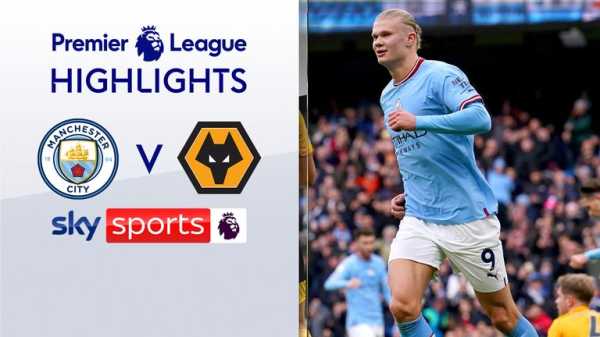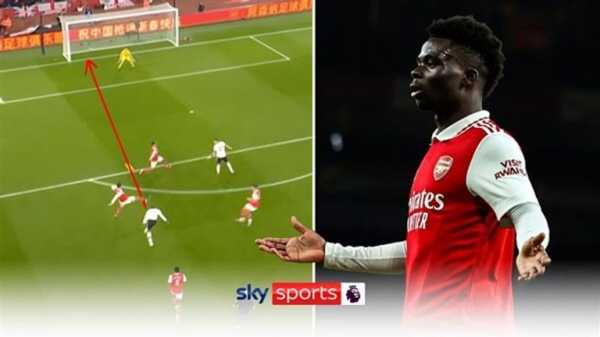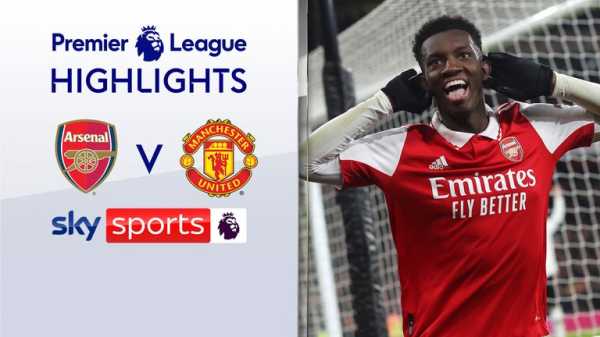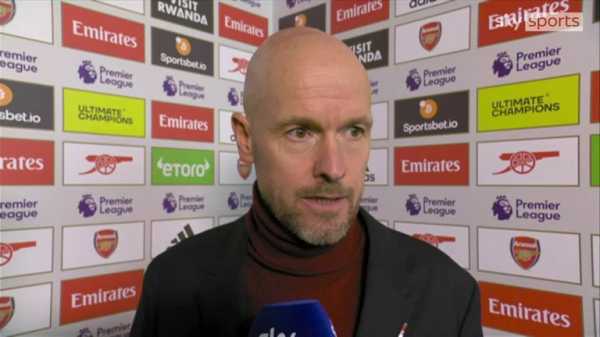
Haaland hat-trick but the debate will go on

FREE TO WATCH: Highlights from Manchester City’s win against Wolves
After Manchester City’s three-goal win over Wolves in which Erling Haaland scored all of the goals, Pep Guardiola made the point that when Haaland scores everyone says that he is the solution and when he does not score everyone says that he is the problem.
That is likely to be how it continues for the striker until and unless he fires City to trophies at the end of the season. On Sunday, he was the solution. Wolves were defending resolutely for much of the first half but Haaland emphatically took the game away from them.
Twenty-five goals in 19 Premier League appearances. A fourth hat-trick. The fastest man to do that in the competition prior to Haaland’s arrival was Ruud van Nistelrooy for Manchester United. He did it in 65 games. These are not normal numbers.
That is worth remembering because Haaland makes the extraordinary look ordinary. The second goal against Wolves was a penalty. The third was stroked into an empty net. It looks straightforward enough but nobody else manages to do it as often as he does it.
Trending
- Transfer Centre LIVE! Kane ‘open to signing new Tottenham contract’
- Keane: It’ll take a lot to stop Arsenal | Fabregas hails Arteta: He’s changed everything
- Keane: Have Man Utd moved on from past problems? | ‘Wan-Bissaka, do your job!’
- Papers: Lampard waiting to learn Everton fate
- Neville: Arsenal of 20 years ago | England call coming for Nketiah
- Arsenal transfer rumours: Kiwior spotted at Emirates Stadium ahead of move
- Eubank Jr: It was a ‘once in a lifetime’ shot by Smith | ‘I was dominating the fight!’
- PL Hits & Misses: Haaland makes the extraordinary look ordinary
- Eubank Jr to ‘let dust settle’ before making Smith rematch decision
- ‘It’s very embarrassing’ – Chelsea vs Liverpool off after six mins
- Video
- Latest News
- Man City 3-0 Wolves – Match report & highlights
- How the teams lined up | Match stats
The Premier League scoring record for a single season is 34 and barring injury Haaland will surely break that with plenty of time to spare. At his current rate of scoring, the final total will be closer to 50 and the record could go as early as March.
When that happens, more words will be spoken and praise will be lavished. We will celebrate Haaland’s finishing on the pitch and his dedication to his craft off the pitch. Guardiola highlighted that his commitment to the game is total, a model professional.
Also See:
But Guardiola also knows that it is what happens after the record has been broken, in April and May, perhaps even June if City reach the Champions League final, that will shape how Manchester City’s Haaland project is viewed at the conclusion of the season.
Beat Arsenal to the title or finally lift that European trophy and his signing will be seen as the catalyst. Come up short and, as crazy as it sounds, even the hat-tricks will not be enough to quieten the debate about whether this scoring giant has made his team better or worse.
Adam Bate
Lack of cutting edge Leeds’ Achilles’ heel

FREE TO WATCH: Highlights from the draw between Leeds and Brentford
Jesse Marsch is insistent his team are close to clicking, it’s just the ‘final action’ that needs refinement. The only missing piece of an otherwise complete puzzle. Problem is, getting the final action correct is not only the most difficult thing to do in football, it’s the most crucial. Leeds were not as close to achieving success in the final third as their optimistic manager suggested after the game, albeit they were much improved defensively.
- Leeds 0-0 Brentford – Match report & highlights
- How the teams lined up | Match stats | Premier League table
An encounter that was once rich in goals (14 in three meetings), and goalmouth action, failed to deliver either. Leeds had plenty of cut and thrust, and they worked the ball well in second-half spells, but all of David Raya’s six saves for Brentford were routine – he was never at full tilt.
Perhaps this is the start of pragmatic Leeds. Perhaps we, as onlookers, need to temper our expectations. Under Marcelo Bielsa, the Yorkshire side thrilled week in, week out, but that proved to be unsustainable in the world’s most competitive league. It was landing Leeds in trouble.
Marsch’s side do not entertain in the same way but they are building a solid foundation. Centre-half Max Wober looked decent on his first Premier League start. Maybe record-signing Georginio Rutter – a forward – should have been afforded the same opportunity to impress.
Laura Hunter
Don’t be fooled by Saka

Both Marcus Rashford and Bukayo Saka netted screamers during Arsenal’s win over Manchester United but who’s was best? You decide…
“He’s a bit of a bluffer as he makes opponents think he’s too nice but when he’s on the pitch he’s a different animal,” Cesc Fabregas told Sky Sports.
Off the pitch, it would be harder to meet a humbler and more engaging human being than Bakayo Saka.
Yet, on the pitch, he knows how to terrorise opposition defenders. Just ask Luke Shaw. The Manchester United full-back, despite training and spending weeks with Saka in the England set-up, had no ideas how to stop him. He was run ragged, backing off towards his own goal on every occasion Saka lined him up one-on-one. It was therefore surprising and a sign of Saka’s talent that his spectacular goal came from distance instead of via one of his 13 touches in the opposition box. He was the outstanding player on the night. As he is most weeks.
- Arsenal 3-2 Man Utd – Match report & highlights
- How the teams lined up | Match stats
As Jamie Redknapp referenced post-match, the Arsenal winger is currently performing at a world-class level and is entering the “unplayable” territory. When building a World XI, Saka would be in the shake-up of playing on the right of the front three.
He may float like a butterfly – but he stings like a bee.
Lewis Jones
‘Reality check’ for Man Utd, but not all doom and gloom

FREE TO WATCH: Highlights from Arsenal’s win against Manchester United in the Premier League.
Man Utd manager Erik ten Hag cut an irritated figure in his post-match press conference after watching his side concede late on to suffer their first Premier League defeat since being thrashed 6-3 at Man City in October.
United had arrived in the capital boasting a similarly impressive unbeaten run to that of their hosts and with genuine belief of repeating their 3-1 win over Arsenal at Old Trafford earlier in the season.
Victory at the Emirates would have seen United move to within just five points of the Gunners, albeit having played a game more than the leaders, which given the state they were in after losing consecutively to Brighton and Brentford at the start of the campaign, would have represented quite some turnaround.
However, it was not to be as United’s defensive frailties were exposed by the home side, with Ten Hag claiming “all three goals were avoidable,” and conceding so late on was “unacceptable”.

Manchester United boss Erik ten Hag was disappointed that his side lost late on at Arsenal and was critical of their defensive display.
The Dutchman was clearly irked the visitors had thrown away an early lead, saying: “We are making the wrong decisions – not one player but many players,” before going on to suggest: “good teams don’t make such mistakes.”
But as with their 4-0 reverse at Brentford back in August, maybe this setback will actually turn out to be a positive for United in the long run, with Ten Hag viewing it as a “reality check” for his players.
And while United are not going to win the title this campaign after Sunday’s loss, the lessons they learn from this setback in north London should stand them in good stead when it comes to challenging next season.
Richard Morgan

Win £250,000 with Super 6!
Another Saturday, another chance to win £250,000 with Super 6. Play for free, entries by 3pm.
Sourse: skysports.com